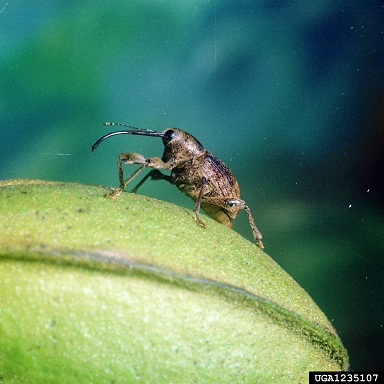Crop Production

The pecan weevil, Curculio caryae, is a common insect pest of pecan and hickory. The insect has an interesting life cycle, and commercial pecan growers spray to control them every year. Since North America is home to most of the hickory species, including pecan, the pecan weevil is a native pest.
The Damage

Pecan weevil larvae damage.
Photographer:Louis Tedders:USDA Agricultural Research Service
Adult pecan weevils emerge from the soil near the first of August in Alabama. Then, they climb into pecan trees and begin feeding on the developing nuts. As these snout beetles feed, they puncture the nuts which causes the nuts to abort and fall from the tree. Many homeowners see this summer drop and are not aware that an insect is the cause.
Eventually the adults mate and the females chew a hole through the shell of the nut and lay an egg on the inside. The egg will then hatch and a grub will develop and feed on the developing kernel.
After feeding, the grub then chews a neat round hole in the shell and crawls out and falls to the ground where it burrows into the soil and pupates.
The Pupae and Control
The pupae will remain in the soil for two years, or occasionally three years. There is always a generation each year so the adults that will emerge in 2019 actually went into the soil in 2017. This adaptation to a long pupal cycle is interesting because it seems to have developed to take advantage of the tendency of alternate fruit-bearing years in pecan.
Commercial growers monitor their orchards for pecan weevil emergence so they can time their sprays to control the insect. The “Tedders Trap” is a pyramidal trap that is set up on the ground and has a trap device on the top and is very similar to the familiar boll weevil traps that were used during the boll weevil eradication program. Some growers also use a sticky substance which captures the adults as they climb. Pecan weevils can also fly, but the traps usually catch the ones that prefer to climb into the tree canopy.
Research related to controlling pecan weevil is ongoing at the USDA Southeastern Fruit and Nut Laboratory in Byron, Georgia. A naturally occurring soil fungus, a bacterium and some beneficial nematodes have been identified that will attack the pupae in the soil. Delivery methods and persistence of these organisms have been the focus of this research.
Until this research yields an effective biological control method, commercial growers will continue spraying to protect their pecan crop.

